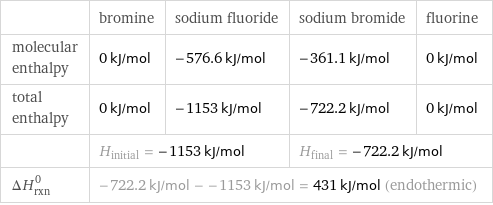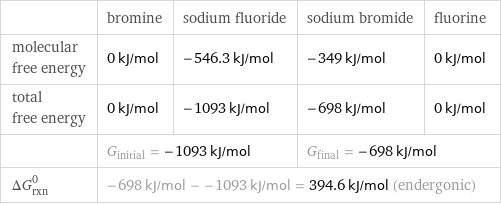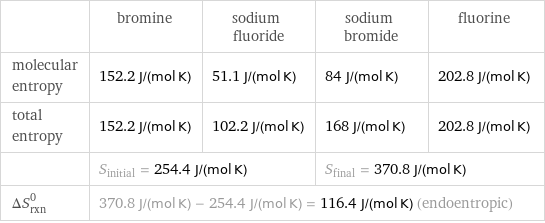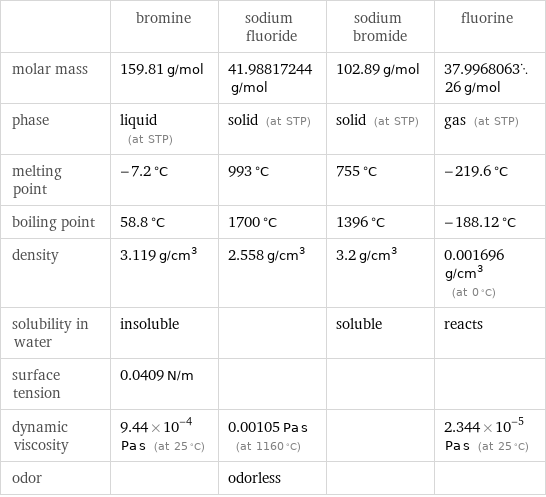Input interpretation

Br_2 bromine + NaF sodium fluoride ⟶ NaBr sodium bromide + F_2 fluorine
Balanced equation

Balance the chemical equation algebraically: Br_2 + NaF ⟶ NaBr + F_2 Add stoichiometric coefficients, c_i, to the reactants and products: c_1 Br_2 + c_2 NaF ⟶ c_3 NaBr + c_4 F_2 Set the number of atoms in the reactants equal to the number of atoms in the products for Br, F and Na: Br: | 2 c_1 = c_3 F: | c_2 = 2 c_4 Na: | c_2 = c_3 Since the coefficients are relative quantities and underdetermined, choose a coefficient to set arbitrarily. To keep the coefficients small, the arbitrary value is ordinarily one. For instance, set c_1 = 1 and solve the system of equations for the remaining coefficients: c_1 = 1 c_2 = 2 c_3 = 2 c_4 = 1 Substitute the coefficients into the chemical reaction to obtain the balanced equation: Answer: | | Br_2 + 2 NaF ⟶ 2 NaBr + F_2
Structures

+ ⟶ +
Names

bromine + sodium fluoride ⟶ sodium bromide + fluorine
Reaction thermodynamics
Enthalpy

| bromine | sodium fluoride | sodium bromide | fluorine molecular enthalpy | 0 kJ/mol | -576.6 kJ/mol | -361.1 kJ/mol | 0 kJ/mol total enthalpy | 0 kJ/mol | -1153 kJ/mol | -722.2 kJ/mol | 0 kJ/mol | H_initial = -1153 kJ/mol | | H_final = -722.2 kJ/mol | ΔH_rxn^0 | -722.2 kJ/mol - -1153 kJ/mol = 431 kJ/mol (endothermic) | | |
Gibbs free energy

| bromine | sodium fluoride | sodium bromide | fluorine molecular free energy | 0 kJ/mol | -546.3 kJ/mol | -349 kJ/mol | 0 kJ/mol total free energy | 0 kJ/mol | -1093 kJ/mol | -698 kJ/mol | 0 kJ/mol | G_initial = -1093 kJ/mol | | G_final = -698 kJ/mol | ΔG_rxn^0 | -698 kJ/mol - -1093 kJ/mol = 394.6 kJ/mol (endergonic) | | |
Entropy

| bromine | sodium fluoride | sodium bromide | fluorine molecular entropy | 152.2 J/(mol K) | 51.1 J/(mol K) | 84 J/(mol K) | 202.8 J/(mol K) total entropy | 152.2 J/(mol K) | 102.2 J/(mol K) | 168 J/(mol K) | 202.8 J/(mol K) | S_initial = 254.4 J/(mol K) | | S_final = 370.8 J/(mol K) | ΔS_rxn^0 | 370.8 J/(mol K) - 254.4 J/(mol K) = 116.4 J/(mol K) (endoentropic) | | |
Equilibrium constant
![Construct the equilibrium constant, K, expression for: Br_2 + NaF ⟶ NaBr + F_2 Plan: • Balance the chemical equation. • Determine the stoichiometric numbers. • Assemble the activity expression for each chemical species. • Use the activity expressions to build the equilibrium constant expression. Write the balanced chemical equation: Br_2 + 2 NaF ⟶ 2 NaBr + F_2 Assign stoichiometric numbers, ν_i, using the stoichiometric coefficients, c_i, from the balanced chemical equation in the following manner: ν_i = -c_i for reactants and ν_i = c_i for products: chemical species | c_i | ν_i Br_2 | 1 | -1 NaF | 2 | -2 NaBr | 2 | 2 F_2 | 1 | 1 Assemble the activity expressions accounting for the state of matter and ν_i: chemical species | c_i | ν_i | activity expression Br_2 | 1 | -1 | ([Br2])^(-1) NaF | 2 | -2 | ([NaF])^(-2) NaBr | 2 | 2 | ([NaBr])^2 F_2 | 1 | 1 | [F2] The equilibrium constant symbol in the concentration basis is: K_c Mulitply the activity expressions to arrive at the K_c expression: Answer: | | K_c = ([Br2])^(-1) ([NaF])^(-2) ([NaBr])^2 [F2] = (([NaBr])^2 [F2])/([Br2] ([NaF])^2)](../image_source/2dc869d56660cf04d19affe5361e7753.png)
Construct the equilibrium constant, K, expression for: Br_2 + NaF ⟶ NaBr + F_2 Plan: • Balance the chemical equation. • Determine the stoichiometric numbers. • Assemble the activity expression for each chemical species. • Use the activity expressions to build the equilibrium constant expression. Write the balanced chemical equation: Br_2 + 2 NaF ⟶ 2 NaBr + F_2 Assign stoichiometric numbers, ν_i, using the stoichiometric coefficients, c_i, from the balanced chemical equation in the following manner: ν_i = -c_i for reactants and ν_i = c_i for products: chemical species | c_i | ν_i Br_2 | 1 | -1 NaF | 2 | -2 NaBr | 2 | 2 F_2 | 1 | 1 Assemble the activity expressions accounting for the state of matter and ν_i: chemical species | c_i | ν_i | activity expression Br_2 | 1 | -1 | ([Br2])^(-1) NaF | 2 | -2 | ([NaF])^(-2) NaBr | 2 | 2 | ([NaBr])^2 F_2 | 1 | 1 | [F2] The equilibrium constant symbol in the concentration basis is: K_c Mulitply the activity expressions to arrive at the K_c expression: Answer: | | K_c = ([Br2])^(-1) ([NaF])^(-2) ([NaBr])^2 [F2] = (([NaBr])^2 [F2])/([Br2] ([NaF])^2)
Rate of reaction
![Construct the rate of reaction expression for: Br_2 + NaF ⟶ NaBr + F_2 Plan: • Balance the chemical equation. • Determine the stoichiometric numbers. • Assemble the rate term for each chemical species. • Write the rate of reaction expression. Write the balanced chemical equation: Br_2 + 2 NaF ⟶ 2 NaBr + F_2 Assign stoichiometric numbers, ν_i, using the stoichiometric coefficients, c_i, from the balanced chemical equation in the following manner: ν_i = -c_i for reactants and ν_i = c_i for products: chemical species | c_i | ν_i Br_2 | 1 | -1 NaF | 2 | -2 NaBr | 2 | 2 F_2 | 1 | 1 The rate term for each chemical species, B_i, is 1/ν_i(Δ[B_i])/(Δt) where [B_i] is the amount concentration and t is time: chemical species | c_i | ν_i | rate term Br_2 | 1 | -1 | -(Δ[Br2])/(Δt) NaF | 2 | -2 | -1/2 (Δ[NaF])/(Δt) NaBr | 2 | 2 | 1/2 (Δ[NaBr])/(Δt) F_2 | 1 | 1 | (Δ[F2])/(Δt) (for infinitesimal rate of change, replace Δ with d) Set the rate terms equal to each other to arrive at the rate expression: Answer: | | rate = -(Δ[Br2])/(Δt) = -1/2 (Δ[NaF])/(Δt) = 1/2 (Δ[NaBr])/(Δt) = (Δ[F2])/(Δt) (assuming constant volume and no accumulation of intermediates or side products)](../image_source/70a4c330b4a104a181c1ad85a5e6071f.png)
Construct the rate of reaction expression for: Br_2 + NaF ⟶ NaBr + F_2 Plan: • Balance the chemical equation. • Determine the stoichiometric numbers. • Assemble the rate term for each chemical species. • Write the rate of reaction expression. Write the balanced chemical equation: Br_2 + 2 NaF ⟶ 2 NaBr + F_2 Assign stoichiometric numbers, ν_i, using the stoichiometric coefficients, c_i, from the balanced chemical equation in the following manner: ν_i = -c_i for reactants and ν_i = c_i for products: chemical species | c_i | ν_i Br_2 | 1 | -1 NaF | 2 | -2 NaBr | 2 | 2 F_2 | 1 | 1 The rate term for each chemical species, B_i, is 1/ν_i(Δ[B_i])/(Δt) where [B_i] is the amount concentration and t is time: chemical species | c_i | ν_i | rate term Br_2 | 1 | -1 | -(Δ[Br2])/(Δt) NaF | 2 | -2 | -1/2 (Δ[NaF])/(Δt) NaBr | 2 | 2 | 1/2 (Δ[NaBr])/(Δt) F_2 | 1 | 1 | (Δ[F2])/(Δt) (for infinitesimal rate of change, replace Δ with d) Set the rate terms equal to each other to arrive at the rate expression: Answer: | | rate = -(Δ[Br2])/(Δt) = -1/2 (Δ[NaF])/(Δt) = 1/2 (Δ[NaBr])/(Δt) = (Δ[F2])/(Δt) (assuming constant volume and no accumulation of intermediates or side products)
Chemical names and formulas

| bromine | sodium fluoride | sodium bromide | fluorine formula | Br_2 | NaF | NaBr | F_2 Hill formula | Br_2 | FNa | BrNa | F_2 name | bromine | sodium fluoride | sodium bromide | fluorine IUPAC name | molecular bromine | sodium fluoride | sodium bromide | molecular fluorine
Substance properties

| bromine | sodium fluoride | sodium bromide | fluorine molar mass | 159.81 g/mol | 41.98817244 g/mol | 102.89 g/mol | 37.996806326 g/mol phase | liquid (at STP) | solid (at STP) | solid (at STP) | gas (at STP) melting point | -7.2 °C | 993 °C | 755 °C | -219.6 °C boiling point | 58.8 °C | 1700 °C | 1396 °C | -188.12 °C density | 3.119 g/cm^3 | 2.558 g/cm^3 | 3.2 g/cm^3 | 0.001696 g/cm^3 (at 0 °C) solubility in water | insoluble | | soluble | reacts surface tension | 0.0409 N/m | | | dynamic viscosity | 9.44×10^-4 Pa s (at 25 °C) | 0.00105 Pa s (at 1160 °C) | | 2.344×10^-5 Pa s (at 25 °C) odor | | odorless | |
Units
